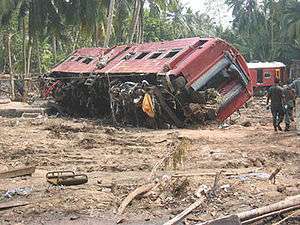2004 Sri Lanka tsunami-rail disaster
 | |
| Date | 26 December 2004 |
|---|---|
| Location | Peraliya, Hikkaduwa |
| Country | Sri Lanka |
| Rail line | Coastal line |
| Operator | Sri Lanka Railways |
| Type of incident | Flood |
| Cause | Tsunami |
| Statistics | |
| Trains | 1 Train (No. 8050) |
| Deaths | Exact figures unknown, at least 1,700+ |
| Injuries | 100+ |
The 2004 Sri Lanka tsunami-rail disaster is the largest single rail disaster in world history by death toll, with at least 1,700 fatalities. It occurred when an overcrowded passenger train was destroyed on a coastal railway in Sri Lanka by a tsunami which followed the 2004 Indian Ocean earthquake.
Train
The train, known locally as the Queen of the Sea Line, was a regular train operating between the cities of Colombo and Galle. The route runs along the southwestern coast of Sri Lanka, and at Telwatta, only about 200 metres (660 ft) inland from the sea. On Sunday, 26 December 2004, during both the Buddhist full moon holiday and the Christmas holiday weekend, it left Colombo shortly after 6:55 A.M. with between 1,000 and 1,500 paid passengers and an unknown number of unpaid passengers.[1]
Tsunami waves strike the crowded train
At 9:30 A.M., in the village of Peraliya, near Telwatta, the beach saw the first of the gigantic waves thrown up by the earthquake, which had recently struck off the coast of Sumatra, Indonesia. The train came to a halt as water surged around it. Hundreds of locals, believing the train to be secure on the rails, climbed onto the top of the cars to avoid being swept away. Others stood behind the train, hoping it would shield them from the force of the water. The first wave flooded the carriages and caused panic amongst the passengers. The next, much larger, wave picked the train up and smashed it against the trees and houses which lined the track, crushing those seeking shelter behind it. The eight carriages were so packed with people that the doors could not be opened while they filled with water, drowning almost everyone inside as the water washed over the wreckage several more times. The passengers on top of the train were thrown clear of the uprooted carriages, and most drowned or were crushed by debris. Estimates based on the state of the shoreline and a high-water mark on a nearby building place the tsunami 7.5 to 9 meters above sea level and 2 to 3 meters higher than the top of the train.[2]
Casualties
Due to the huge scale of the disaster, the local authorities were unable to cope with the devastation, and emergency services and the military were so overwhelmed that immediate rescue was not possible. In fact, the Sri Lankan authorities had no idea where the train was for several hours, until it was spotted from an airplane. The local emergency services were destroyed, and it was a long time before help arrived. Dozens of people badly injured in the disaster died in the wreckage during the day, and many bodies were not retrieved for over a week. Some families descended on the area determined to find their relatives themselves.

According to the Sri Lankan authorities, only a few dozen people on the train survived. The estimated death toll was at least 1,700 people, and probably over 2,000, although only approximately 900 bodies were recovered, as many were swept out to sea or taken away by relatives. The town of Peraliya was also destroyed, losing hundreds of citizens to the waves and all but ten buildings. Over 200 of the bodies retrieved were not identified or claimed, and were buried three days later in a Buddhist ceremony near the torn railway line.
Aftermath
The first anniversary ceremonies were held amongst the rebuilt town alongside the repaired railway, which still operates a Colombo to Galle service, employing the same guard who was on the train and survived the disaster. The train, now restored with the same locomotive (Class M2a No. 591) and two of its original carriages, returned to Paraliya on 26 December 2008, four years after the disaster. A religious ceremony and a memorial was held to remember those who lost their lives four years previously. It has now returned to regular service on the coastal line.[3]
See also
Notes
- ↑ Carl Strand and John Masek, ed. (August 2008). Sumatra-Andaman Islands Earthquake and Tsunami of December 26, 2004: Lifeline Performance. Reston, VA: ASCE Press, Technical Council on Lifeline Earthquake Engineering. ISBN 978-0-7844-0951-0.
- ↑ Carl Strand and John Masek, ed. (August 2008). Sumatra-Andaman Islands Earthquake and Tsunami of December 26, 2004: Lifeline Performance. Reston, VA: ASCE Press, Technical Council on Lifeline Earthquake Engineering. ISBN 978-0-7844-0951-0.
- ↑ Daily Mirror Online Edition, 26 December 2008.
External links
- BBC News Report
- USA Today Report
- Traveler's report
- BBC One year anniversary
- Sri Lankan account
- The Peraliya Official Website
- Steele, Jonathan. "One train, more than 1,700 dead.", The Guardian. 29 December 2004.
- Daily Mirror 26.12.2008
Coordinates: 6°10′08″N 80°05′28″E / 6.169°N 80.091°E
| ||||||||||